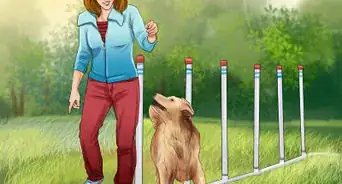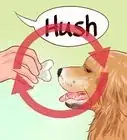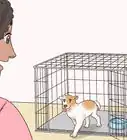This article was co-authored by Pippa Elliott, MRCVS. Dr. Elliott, BVMS, MRCVS is a veterinarian with over 30 years of experience in veterinary surgery and companion animal practice. She graduated from the University of Glasgow in 1987 with a degree in veterinary medicine and surgery. She has worked at the same animal clinic in her hometown for over 20 years.
wikiHow marks an article as reader-approved once it receives enough positive feedback. In this case, 92% of readers who voted found the article helpful, earning it our reader-approved status.
This article has been viewed 128,897 times.
Some breeds of dogs have herding instincts that can be brought out with the right training and encouragement. Try some basic training exercises at home to teach your dog basic obedience and assess see if it displays herding tendencies. It is recommended that you consider detailed tutorials or professional training to pursue a serious future in dog herding. Talk to your veterinarian to see if your dog has the basic genetic makeup to be a herder. Common breeds are Border Collies, Australian Shepherds, Australian Cattle Dogs, Corgis, and Shetland Sheepdogs.
Steps
Preparing Your Dog For Herding
-
1Teach your dog basic training tricks. Even non-herding breeds can easily be taught to sit, come, lie down, and heel whether or not you continue their training. Unless your dog knows how to be obedient off-leash and listen to you despite distractions, training to herd sheep will be difficult, if not impossible.
-
2Take note of your dog’s behavior. A dog with solid herding instincts will display this aptitude early on. Look for your dog moving around you or other animals in a circular motion. If your dog does not display early signs of these instincts, you may not be able to train it to herd.Advertisement
-
3Consider professional training. If you are serious about dog herding, you should consider training yourself or the dog sooner rather than later. The earlier in your dog’s life you use the most up-to-date training techniques, the better the result. It is possible to teach your dog more advanced commands without professional help, but only the most instinctive herders will pick it up easily.[1]
-
4Play catch with your dog. As soon as you take your dog home, start getting it to retrieve balls or toys for you. As soon as you can, teach it to get the toy only at your command. This will develop its instincts for chasing as well as basic obedience.[2]
-
5Teach your dog directional movement. It is important that your dog learn verbal commands for left and right. Use a leash and walk your dog through the motions. Combine this with repetitive verbal commands so your dog learns the association.
- Teach your dog to run right, or clockwise, when you say “come bye” or “bye” for short.
- The command for left, or counterclockwise, is “away to me” or “’way” for short.
- Get your dog used to stopping and lying down when you say “wait,” “lie down,” “sit,” or a similar word.
Practicing Herding Commands With Livestock
-
1Get your dog acclimated to livestock. You don’t want your dog’s first encounter with livestock on show day. Get it used to obeying your commands around sheep and other animals. Contact local dog herding associations to find out where you can take your dog to meet livestock.[3]
-
2Train your dog to herd a real animal. See if you can buy or get access to a lamb or duck for your dog to practice herding. Put them in a small kennel and practice the basic commands “come bye” and “away to me.” Now is a good time to practice your “lie down” command. Get your dog used to obeying your basic commands.[4]
-
3Watch your dog's body language. It should be clear if your dog has the right instincts for advanced herding. Its tail should go down when it is around the flock, meaning that it is thinking. It should naturally run circles around the livestock and respond to your commands. You can only take this interest as far as your dog will let you, so respect natural limits.
-
4Move onto more complex commands. Once your dog is obedient to you, acclimated to livestock, and knows basic commands, teach them useful maneuvers. Getting your dog to run around the herd is useful, but the ability to move it from place to place is the next step. Work toward a practical application of herding commands.
- Outrun: your dog will run past the flock and stop them from moving away from you. This is important to getting the flock under control.
- The lift: your dog has to introduce itself to the flock. Working on this move will get the flock to respect your dog and follow its directions.
- The fetch: in this move, your dog will work the flock back to you. This has an important applicability for working dogs.
-
5Enroll in classes or shows. The basics for herding will only get you so far. If you want to take this hobby further and compete in shows, you need to teach your dog more complex commands. There are a host of herding commands that you may need to know on show day. Teaching them to your dog may require a little more expertise than you have been able to pick up thus far.
- If your dog displays little enthusiasm for the classes, it may not be well-suited for herding. You should always pay attention to the wants and needs of your dog.
-
6Enroll in tests and trials. When it is time, sign you and your dog up for a show. The excitement of having lots of dogs, people, and new scents and sounds will be confusing for your dog at first. You will probably have to compete in a few shows before your dog scores some wins.[5]
Expert Q&A
Did you know you can get expert answers for this article?
Unlock expert answers by supporting wikiHow
-
QuestionAn Australian shepherd plays with my dog and pulls her ears to get her to join in. Do they do this to sheep when herding?
 Pippa Elliott, MRCVSDr. Elliott, BVMS, MRCVS is a veterinarian with over 30 years of experience in veterinary surgery and companion animal practice. She graduated from the University of Glasgow in 1987 with a degree in veterinary medicine and surgery. She has worked at the same animal clinic in her hometown for over 20 years.
Pippa Elliott, MRCVSDr. Elliott, BVMS, MRCVS is a veterinarian with over 30 years of experience in veterinary surgery and companion animal practice. She graduated from the University of Glasgow in 1987 with a degree in veterinary medicine and surgery. She has worked at the same animal clinic in her hometown for over 20 years.
Veterinarian
-
QuestionHow do I go about getting professional training help with my dog?
 Pippa Elliott, MRCVSDr. Elliott, BVMS, MRCVS is a veterinarian with over 30 years of experience in veterinary surgery and companion animal practice. She graduated from the University of Glasgow in 1987 with a degree in veterinary medicine and surgery. She has worked at the same animal clinic in her hometown for over 20 years.
Pippa Elliott, MRCVSDr. Elliott, BVMS, MRCVS is a veterinarian with over 30 years of experience in veterinary surgery and companion animal practice. She graduated from the University of Glasgow in 1987 with a degree in veterinary medicine and surgery. She has worked at the same animal clinic in her hometown for over 20 years.
Veterinarian Talk to other dog walkers in your area and see who they recommend. Always look for a trainer who uses reward-based training methods. Check if the trainer is certified with a professional body. If your dog has a behavioral issues, then speak to your vet, who can refer you to a registered behavioral specialist.
Talk to other dog walkers in your area and see who they recommend. Always look for a trainer who uses reward-based training methods. Check if the trainer is certified with a professional body. If your dog has a behavioral issues, then speak to your vet, who can refer you to a registered behavioral specialist.
Sources and References
- ↑ http://www.akc.org/events/herding/herdsman/articles/page-16/
- ↑ http://www.akc.org/events/herding/getting-started/
- ↑ http://www.animalplanet.com/pets/do-dogs-automatically-know-how-to-herd/
- ↑ http://www.tractorsupply.com/know-how_Dog-Training_training-border-collies-and-herding-dogs
- ↑ http://www.akc.org/events/herding/getting-started/
About This Article
To teach your dog to herd, keep in mind that it may be difficult to train a dog to herd that hasn't displayed herding instincts since it was young. Before you try to train your dog to herd, work on basic skills like retrieving a ball, lying down on command, and understanding verbal commands for left and right. Then, once your dog is comfortable with that, contact a local dog herding association to find out where you can bring your dog to meet livestock and practice herding. For more tips from our Veterinary co-author, like how to teach your dog commands, read on!






































































